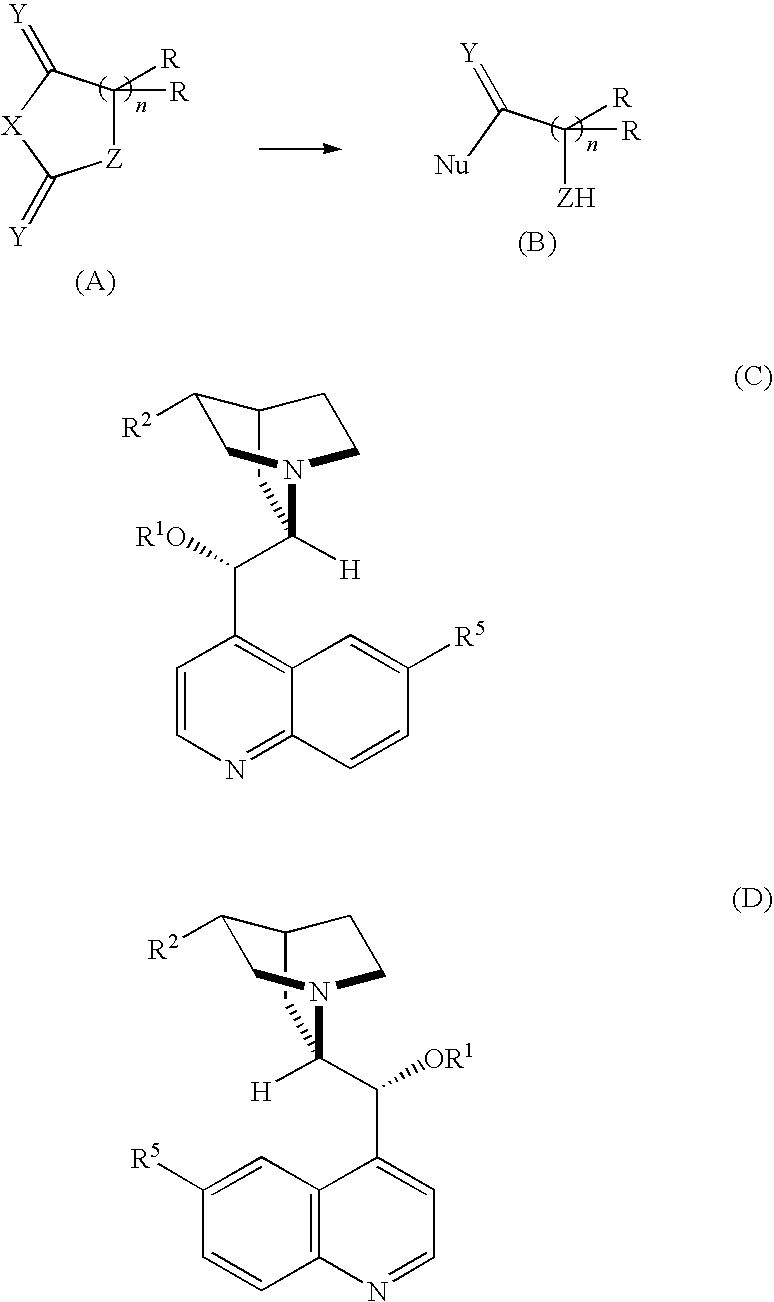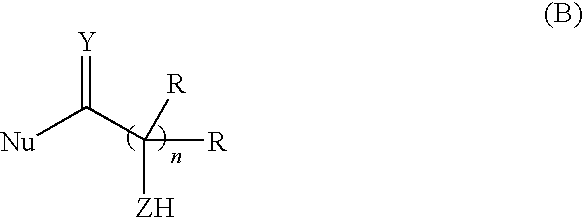Optically active compounds, method for kinetic optical resolution of carboxylic acid derivatives and catalysts therefor
a technology of kinetic optical resolution and carboxylic acid, which is applied in the preparation of organic compounds/hydrides/coordination complexes catalysts, physical/chemical process catalysts, and asymmetrical anhydrides. it can solve the problems of troublesome operation, unsuitable method for obtaining large amounts of optically active compounds, and remarkable limited compounds
- Summary
- Abstract
- Description
- Claims
- Application Information
AI Technical Summary
Benefits of technology
Problems solved by technology
Method used
Image
Examples
example 1
[0128]Molecular sieve 4A (10 mg) was added to a solution of N-allyloxycarbonyl-4-benzyl-1,3-oxazoline-2,5-dione (substrate (1)a; 27.5 mg, 0.1 mmol) in anhydrous ether (4 ml) (concentration: 25 mmol / l) derived from phenylalanine, which is a racemic α-amino acid. The mixture was cooled to −60° C., and Me-QD (13.5 mg, 0.4 equivalent) was added to the mixture. After stirring for five minutes, a 5% anhydrous ethanol / ether solution (50 μl; ethanol: 0.6 equivalent) was added thereto slowly with a syringe. The reaction mixture was stirred at this temperature for 30 hours, and then a 0.2 N aqueous hydrochloric acid solution (5 ml) was added to the reaction mixture to stop the reaction. The temperature was raised to room temperature, the aqueous and organic layers were separated, and the aqueous hydrochloric acid layer was extracted with diethyl ether (2×2 ml). The combined organic layer was dried over anhydrous sodium sulfate, and the extraction solvent was evaporated under reduced pressure....
example 34
[0137]An experiment was performed in the same manner as in Example 1 except that the reagents, the reaction conditions and the like were changed as shown in Table 1 to give results shown in Table 2.
[0138]The reaction in this Example is represented by the formula (2).
[0139]
example 35
[0141]An experiment was performed in the same manner as in Example 1 except that the reagents, the reaction conditions and the like were changed as shown in Table 1 to give results shown in Table 2.
[0142]The reaction in this Example is represented by the formula (3).
[0143]
PUM
| Property | Measurement | Unit |
|---|---|---|
| temperature | aaaaa | aaaaa |
| temperature | aaaaa | aaaaa |
| temperature | aaaaa | aaaaa |
Abstract
Description
Claims
Application Information
 Login to View More
Login to View More - R&D
- Intellectual Property
- Life Sciences
- Materials
- Tech Scout
- Unparalleled Data Quality
- Higher Quality Content
- 60% Fewer Hallucinations
Browse by: Latest US Patents, China's latest patents, Technical Efficacy Thesaurus, Application Domain, Technology Topic, Popular Technical Reports.
© 2025 PatSnap. All rights reserved.Legal|Privacy policy|Modern Slavery Act Transparency Statement|Sitemap|About US| Contact US: help@patsnap.com



